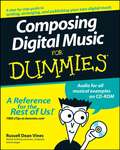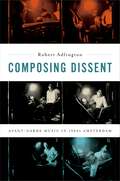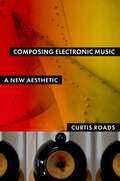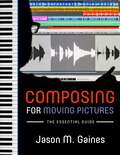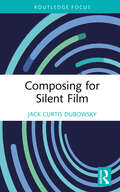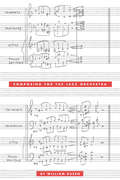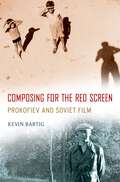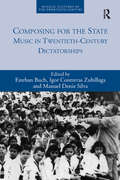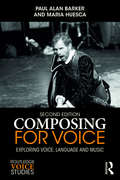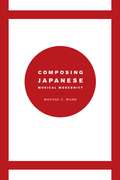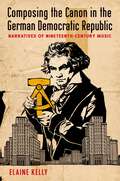- Table View
- List View
Composing Digital Music For Dummies
by Russell Dean VinesYes, you can turn those great melodies and smokin’ grooves in your head into stunning digital music! And you don’t have to be a musical genius or a computer geek to do it! Composing Digital Music For Dummies shows you everything you need to know to compose great tunes using the hottest digital tools. This friendly, plain-English guide explains all of the digital music basics, including how to work with the latest hardware and software, use templates from the companion CD-ROM to make a quick start, build your first tune, and save it in different formats. You’ll also find out how to add instruments to your score, set tempos and keys, create chord symbols and show fretboards, add lyrics to your tune, and much more. Discover how to: Write and arrange digital music Determine what — if any — equipment you need Create your own ringtones and mp3s Compose with a MIDI controller, or a mouse Work with notation software Use keyboard shortcuts Publish your creations on the Internet Build your own tune from scratch Extract parts from your score for each instrument The companion CD-Rom also includes a demo of Sebelius 5, the most popular music notation software, as well as audio files for all music examples in the book. With this step-by-step guide and your computer, you’ll have everything you need to start writing, arranging, and publishing your own digital music — immediately! Note: CD-ROM/DVD and other supplementary materials are not included as part of eBook file.
Composing Digital Music For Dummies
by Russell Dean VinesYes, you can turn those great melodies and smokin’ grooves in your head into stunning digital music! And you don’t have to be a musical genius or a computer geek to do it! Composing Digital Music For Dummies shows you everything you need to know to compose great tunes using the hottest digital tools. This friendly, plain-English guide explains all of the digital music basics, including how to work with the latest hardware and software, use templates from the companion CD-ROM to make a quick start, build your first tune, and save it in different formats. You’ll also find out how to add instruments to your score, set tempos and keys, create chord symbols and show fretboards, add lyrics to your tune, and much more. Discover how to: Write and arrange digital music Determine what — if any — equipment you need Create your own ringtones and mp3s Compose with a MIDI controller, or a mouse Work with notation software Use keyboard shortcuts Publish your creations on the Internet Build your own tune from scratch Extract parts from your score for each instrument The companion CD-Rom also includes a demo of Sebelius 5, the most popular music notation software, as well as audio files for all music examples in the book. With this step-by-step guide and your computer, you’ll have everything you need to start writing, arranging, and publishing your own digital music — immediately! Note: CD-ROM/DVD and other supplementary materials are not included as part of eBook file.
Composing Dissent: Avant-garde Music in 1960s Amsterdam
by Robert AdlingtonThe 1960s saw the emergence in the Netherlands of a generation of avant-garde musicians (including figures such as Louis Andriessen, Willem Breuker, Reinbert de Leeuw and Misha Mengelberg) who were to gain international standing and influence as composers, performers and teachers, and who had a defining impact upon Dutch musical life. Fundamental to their activities in the sixties was a pronounced commitment to social and political engagement. The lively culture of activism and dissent on the streets of Amsterdam prompted an array of vigorous responses from these musicians, including collaborations with countercultural and protest groups, campaigns and direct action against established musical institutions, new grassroots performing associations, political concerts, polemicising within musical works, and the advocacy of new, more 'democratic' relationships with both performers and audiences. These activities laid the basis for the unique new music scene that emerged in the Netherlands in the 1970s and which has been influential upon performers and composers worldwide. This book is the first sustained scholarly examination of this subject. It presents the Dutch experience as an exemplary case study in the complex and conflictual encounter of the musical avant-garde with the decade's currents of social change. The narrative is structured around a number of the decade's defining topoi: modernisation and 'the new'; anarchy; participation; politics; self-management; and popular music. Dutch avant-garde musicians engaged actively with each of these themes, but in so doing they found themselves faced with distinct and sometimes intractable challenges, caused by the chafing of their political and aesthetic commitments. In charting a broad chronological progress from the commencement of work on Peter Schat's Labyrint in 1961 to the premiere of Louis Andriessen's Volkslied in 1971, this book traces the successive attempts of Dutch avant-garde musicians to reconcile the era's evolving social agendas with their own adventurous musical practice.
Composing Electronic Music: A New Aesthetic
by Curtis RoadsElectronic music evokes new sensations, feelings, and thoughts in both composers and listeners. Opening the door to an unlimited universe of sound, it engages spatialization as an integral aspect of composition and focuses on sound transformation as a core structural strategy. In this new domain, pitch occurs as a flowing and ephemeral substance that can be bent, modulated, or dissolved into noise. Similarly, time occurs not merely as a fixed duration subdivided by ratios, but as a plastic medium that can be generated, modulated, reversed, warped, scrambled, and granulated. Envelope and waveform undulations on all time scales interweave to generate form. The power of algorithmic methods amplify the capabilities of music technology. Taken together, these constitute game-changing possibilities. This convergence of technical and aesthetic trends prompts the need for a new text focused on the opportunities of a sound oriented, multiscale approach to composition of electronic music. Sound oriented means a practice that takes place in the presence of sound. Multiscale means an approach that takes into account the perceptual and physical reality of multiple, interacting time scales-each of which can be composed. After more than a century of research and development, now is an appropriate moment to step back and reevaluate all that has changed under the ground of artistic practice. Composing Electronic Music outlines a new theory of composition based on the toolkit of electronic music techniques. The theory consists of a framework of concepts and a vocabulary of terms describing musical materials, their transformation, and their organization. Central to this discourse is the notion of narrative structure in composition-how sounds are born, interact, transform, and die. It presents a guidebook: a tour of facts, history, commentary, opinions, and pointers to interesting ideas and new possibilities to consider and explore.
Composing Electronic Music: A New Aesthetic
by Curtis RoadsElectronic music evokes new sensations, feelings, and thoughts in both composers and listeners. Opening the door to an unlimited universe of sound, it engages spatialization as an integral aspect of composition and focuses on sound transformation as a core structural strategy. In this new domain, pitch occurs as a flowing and ephemeral substance that can be bent, modulated, or dissolved into noise. Similarly, time occurs not merely as a fixed duration subdivided by ratios, but as a plastic medium that can be generated, modulated, reversed, warped, scrambled, and granulated. Envelope and waveform undulations on all time scales interweave to generate form. The power of algorithmic methods amplify the capabilities of music technology. Taken together, these constitute game-changing possibilities. This convergence of technical and aesthetic trends prompts the need for a new text focused on the opportunities of a sound oriented, multiscale approach to composition of electronic music. Sound oriented means a practice that takes place in the presence of sound. Multiscale means an approach that takes into account the perceptual and physical reality of multiple, interacting time scales-each of which can be composed. After more than a century of research and development, now is an appropriate moment to step back and reevaluate all that has changed under the ground of artistic practice. Composing Electronic Music outlines a new theory of composition based on the toolkit of electronic music techniques. The theory consists of a framework of concepts and a vocabulary of terms describing musical materials, their transformation, and their organization. Central to this discourse is the notion of narrative structure in composition-how sounds are born, interact, transform, and die. It presents a guidebook: a tour of facts, history, commentary, opinions, and pointers to interesting ideas and new possibilities to consider and explore.
COMPOSING FOR MOVING PICTURES C: The Essential Guide
by Jason M. GainesMaking quality moving pictures has never been easier or more affordable, and the proliferation and ease of access to digital recording devices has prompted scores of amateurs to record and post videos to YouTube and its ilk. Paradoxically, however, scoring and arranging music for motion pictures is, in many ways, more complicated now than ever before, requiring extensive knowledge of notation, arranging, recording, and mixing software and multi-component DAW workstations. In Composing for Moving Pictures: The Essential Guide, author Jason Gaines offers practical tools with which to navigate the increasingly complex environment of movie music composition. He addresses both the principles of composition for moving pictures and the technologies which drive music composition, performance, and recording in an integrated and comprehensive fashion. The guide takes readers from square one - how technology can facilitate, rather than hinder, creativity in scoring - and then moves into the basics of working with MIDI files and on to more advanced concepts such as arranging and mixing. Gaines illustrates each step of the process with screen shots and explanations in the form of program tutorials. Composing for Moving Pictures fills a hole in literature on film scoring in the digital age and will prove to be an invaluable resource for music educators at the university and secondary level. Amateur composers will also delight in this easy-to-use guidebook.
Composing for Silent Film
by Jack Curtis DubowskyComposing for Silent Film offers insight, information, and techniques for contemporary composition, arrangement, and live score performance for period silent film. A specialized music composition guide, this book complements existing film scoring and contemporary music composition texts. This book helps today’s composers better understand and correctly interpret period silent film, and to create and perform live scores that align with films’ original intentions, so that audiences notice and grasp fine points of the original film. Composing for Silent Film analyzes period silent film and its conventions – from Delsarte acting gestures to period fascinations and subtexts. As a practical composition text, it weighs varying approaches, including improvisation, through-scoring, "mickey-mousing," handling dialogue, and dividing roles amongst players. It steers composers towards informed understanding of silent film, and encourages them to deploy contemporary styles and techniques in exciting ways.For clarity and concision, examples are limited to nine canonical silents: Metropolis, Dr. Jekyll and Mr. Hyde, The Mark of Zorro, Sunrise: A Song of Two Humans, The Black Pirate, Nosferatu, The Phantom Carriage, Daisy Doodad’s Dial, and The Golem.
Composing for Silent Film
by Jack Curtis DubowskyComposing for Silent Film offers insight, information, and techniques for contemporary composition, arrangement, and live score performance for period silent film. A specialized music composition guide, this book complements existing film scoring and contemporary music composition texts. This book helps today’s composers better understand and correctly interpret period silent film, and to create and perform live scores that align with films’ original intentions, so that audiences notice and grasp fine points of the original film. Composing for Silent Film analyzes period silent film and its conventions – from Delsarte acting gestures to period fascinations and subtexts. As a practical composition text, it weighs varying approaches, including improvisation, through-scoring, "mickey-mousing," handling dialogue, and dividing roles amongst players. It steers composers towards informed understanding of silent film, and encourages them to deploy contemporary styles and techniques in exciting ways.For clarity and concision, examples are limited to nine canonical silents: Metropolis, Dr. Jekyll and Mr. Hyde, The Mark of Zorro, Sunrise: A Song of Two Humans, The Black Pirate, Nosferatu, The Phantom Carriage, Daisy Doodad’s Dial, and The Golem.
Composing for the Jazz Orchestra
by William Russo"Although it will be of primary interest to those who are engaged in composition themselves, [this] book is also recommended for readers who may wish to gain further insight into just what makes jazz composition so different from traditional approaches."—Malcolm Bessom, The Music Magazine
Composing for the Jazz Orchestra
by William Russo"Although it will be of primary interest to those who are engaged in composition themselves, [this] book is also recommended for readers who may wish to gain further insight into just what makes jazz composition so different from traditional approaches."—Malcolm Bessom, The Music Magazine
Composing for the Jazz Orchestra
by William Russo"Although it will be of primary interest to those who are engaged in composition themselves, [this] book is also recommended for readers who may wish to gain further insight into just what makes jazz composition so different from traditional approaches."—Malcolm Bessom, The Music Magazine
Composing for the Jazz Orchestra
by William Russo"Although it will be of primary interest to those who are engaged in composition themselves, [this] book is also recommended for readers who may wish to gain further insight into just what makes jazz composition so different from traditional approaches."—Malcolm Bessom, The Music Magazine
Composing for the Red Screen: Prokofiev and Soviet Film (Oxford Music / Media)
by Kevin BartigSound film captivated Sergey Prokofiev during the final two decades of his life: he considered composing for nearly two dozen pictures, eventually undertaking eight of them, all Soviet productions. Hollywood luminaries such as Gloria Swanson tempted him with commissions, and arguably more people heard his film music than his efforts in all other genres combined. Films for which Prokofiev composed, in particular those of Sergey Eisenstein, are now classics of world cinema. Drawing on newly available sources, Composing for the Red Screen examines - for the first time - the full extent of this prodigious cinematic career. Author Kevin Bartig examines how Prokofiev's film music derived from a self-imposed challenge: to compose "serious" music for a broad audience. The picture that emerges is of a composer seeking an individual film-music voice, shunning Hollywood models and objecting to his Soviet colleagues' ideologically expedient film songs. Looking at Prokofiev's film music as a whole - with well-known blockbusters like Alexander Nevsky considered alongside more obscure or aborted projects - reveals that there were multiple solutions to the challenge, each with varying degrees of success. Prokofiev carefully balanced his own populist agenda, the perceived aesthetic demands of the films themselves, and, later on, Soviet bureaucratic demands for accessibility.
Composing for the Red Screen: Prokofiev and Soviet Film (Oxford Music / Media)
by Kevin BartigSound film captivated Sergey Prokofiev during the final two decades of his life: he considered composing for nearly two dozen pictures, eventually undertaking eight of them, all Soviet productions. Hollywood luminaries such as Gloria Swanson tempted him with commissions, and arguably more people heard his film music than his efforts in all other genres combined. Films for which Prokofiev composed, in particular those of Sergey Eisenstein, are now classics of world cinema. Drawing on newly available sources, Composing for the Red Screen examines - for the first time - the full extent of this prodigious cinematic career. Author Kevin Bartig examines how Prokofiev's film music derived from a self-imposed challenge: to compose "serious" music for a broad audience. The picture that emerges is of a composer seeking an individual film-music voice, shunning Hollywood models and objecting to his Soviet colleagues' ideologically expedient film songs. Looking at Prokofiev's film music as a whole - with well-known blockbusters like Alexander Nevsky considered alongside more obscure or aborted projects - reveals that there were multiple solutions to the challenge, each with varying degrees of success. Prokofiev carefully balanced his own populist agenda, the perceived aesthetic demands of the films themselves, and, later on, Soviet bureaucratic demands for accessibility.
Composing for the State: Music in Twentieth-Century Dictatorships (Musical Cultures of the Twentieth Century)
by Esteban Buch Igor Contreras Zubillaga Manuel Deniz SilvaUnder the dictatorships of the twentieth century, music never ceased to sound. Even when they did not impose aesthetic standards, these regimes tended to favour certain kinds of art music such as occasional works for commemorations or celebrations, symphonic poems, cantatas and choral settings. In the same way, composers who were more or less ideologically close to the regime wrote pieces of music on their own initiative, which amounted to a support of the political order. This book presents ten studies focusing on music inspired and promoted by regimes such as Nazi Germany, Fascist Italy, France under Vichy, the USSR and its satellites, Franco's Spain, Salazar's Portugal, Maoist China, and Latin-American dictatorships. By discussing the musical works themselves, whether they were conceived as ways to provide "music for the people", to personally honour the dictator, or to participate in State commemorations of glorious historical events, the book examines the relationship between the composers and the State. This important volume, therefore, addresses theoretical issues long neglected by both musicologists and historians: What is the relationship between art music and propaganda? How did composers participate in musical life under the control of an authoritarian State? What was specifically political in the works produced in these contexts? How did audiences react to them? Can we speak confidently about "State music"? In this way, Composing for the State: Music in Twentieth Century Dictatorships is an essential contribution to our understanding of musical cultures of the twentieth century, as well as the symbolic policies of dictatorial regimes.
Composing for the State: Music in Twentieth-Century Dictatorships (Musical Cultures of the Twentieth Century)
by Esteban Buch Igor Contreras Zubillaga Manuel Deniz SilvaUnder the dictatorships of the twentieth century, music never ceased to sound. Even when they did not impose aesthetic standards, these regimes tended to favour certain kinds of art music such as occasional works for commemorations or celebrations, symphonic poems, cantatas and choral settings. In the same way, composers who were more or less ideologically close to the regime wrote pieces of music on their own initiative, which amounted to a support of the political order. This book presents ten studies focusing on music inspired and promoted by regimes such as Nazi Germany, Fascist Italy, France under Vichy, the USSR and its satellites, Franco's Spain, Salazar's Portugal, Maoist China, and Latin-American dictatorships. By discussing the musical works themselves, whether they were conceived as ways to provide "music for the people", to personally honour the dictator, or to participate in State commemorations of glorious historical events, the book examines the relationship between the composers and the State. This important volume, therefore, addresses theoretical issues long neglected by both musicologists and historians: What is the relationship between art music and propaganda? How did composers participate in musical life under the control of an authoritarian State? What was specifically political in the works produced in these contexts? How did audiences react to them? Can we speak confidently about "State music"? In this way, Composing for the State: Music in Twentieth Century Dictatorships is an essential contribution to our understanding of musical cultures of the twentieth century, as well as the symbolic policies of dictatorial regimes.
Composing for Voice: Exploring Voice, Language and Music (Routledge Voice Studies)
by Paul Barker Maria HuescaComposing for Voice: Exploring Voice, Language and Music, Second Edition, elucidates how language and music function together from the perspectives of composers, singers and actors, providing an understanding of the complex functions of the voice pedagogically, musicologically and dramatically. Composing for Voice examines the voice across a wide range of musical genres (including pop, jazz, folk, classical, opera and the musical) and explores the fusion of language and music that is unique to song. This second edition is enlarged to attract a wider readership amongst all music and theatre professionals and educators, whilst also engaging an international audience with the introduction of new co-author Maria Huesca. New to the second edition: A review of the history of singing An overview of the development of melisma A chapter to help performers understand each other, as singers and actors often receive disparate educations Case studies and qualitative research around song, lyric and meaning A discussion of the synthetic voice An introduction to the concept of embodied composition Interviews with composers and singers Summaries of various vocal styles A website with links to performances discussed, as well as related workshops: www.composingforvoice.com Composing for Voice: Exploring Voice, Language and Music, Second Edition, articulates possibilities for the practical exploration of language, music and voice by composers, singers and actors.
Composing for Voice: Exploring Voice, Language and Music (Routledge Voice Studies)
by Paul Barker Maria HuescaComposing for Voice: Exploring Voice, Language and Music, Second Edition, elucidates how language and music function together from the perspectives of composers, singers and actors, providing an understanding of the complex functions of the voice pedagogically, musicologically and dramatically. Composing for Voice examines the voice across a wide range of musical genres (including pop, jazz, folk, classical, opera and the musical) and explores the fusion of language and music that is unique to song. This second edition is enlarged to attract a wider readership amongst all music and theatre professionals and educators, whilst also engaging an international audience with the introduction of new co-author Maria Huesca. New to the second edition: A review of the history of singing An overview of the development of melisma A chapter to help performers understand each other, as singers and actors often receive disparate educations Case studies and qualitative research around song, lyric and meaning A discussion of the synthetic voice An introduction to the concept of embodied composition Interviews with composers and singers Summaries of various vocal styles A website with links to performances discussed, as well as related workshops: www.composingforvoice.com Composing for Voice: Exploring Voice, Language and Music, Second Edition, articulates possibilities for the practical exploration of language, music and voice by composers, singers and actors.
Composing Japanese Musical Modernity (Chicago Studies in Ethnomusicology)
by Bonnie C. WadeWhen we think of composers, we usually envision an isolated artist separate from the orchestra—someone alone in a study, surround by staff paper—and in Europe and America this image generally has been accurate. For most of Japan’s musical history, however, no such role existed—composition and performance were deeply intertwined. Only when Japan began to embrace Western culture in the late nineteenth century did the role of the composer emerge. In Composing Japanese Musical Modernity, Bonnie Wade uses an investigation of this new musical role to offer new insights not just into Japanese music but Japanese modernity at large and global cosmopolitan culture. Wade examines the short history of the composer in Japanese society, looking at the creative and economic opportunities that have sprung up around them—or that they forged—during Japan’s astonishingly fast modernization. She shows that modernist Japanese composers have not bought into the high modernist concept of the autonomous artist, instead remaining connected to the people. Articulating Japanese modernism in this way, Wade tells a larger story of international musical life, of the spaces in which tradition and modernity are able to meet and, ultimately, where modernity itself has been made.
Composing Japanese Musical Modernity (Chicago Studies in Ethnomusicology)
by Bonnie C. WadeWhen we think of composers, we usually envision an isolated artist separate from the orchestra—someone alone in a study, surround by staff paper—and in Europe and America this image generally has been accurate. For most of Japan’s musical history, however, no such role existed—composition and performance were deeply intertwined. Only when Japan began to embrace Western culture in the late nineteenth century did the role of the composer emerge. In Composing Japanese Musical Modernity, Bonnie Wade uses an investigation of this new musical role to offer new insights not just into Japanese music but Japanese modernity at large and global cosmopolitan culture. Wade examines the short history of the composer in Japanese society, looking at the creative and economic opportunities that have sprung up around them—or that they forged—during Japan’s astonishingly fast modernization. She shows that modernist Japanese composers have not bought into the high modernist concept of the autonomous artist, instead remaining connected to the people. Articulating Japanese modernism in this way, Wade tells a larger story of international musical life, of the spaces in which tradition and modernity are able to meet and, ultimately, where modernity itself has been made.
Composing Japanese Musical Modernity (Chicago Studies in Ethnomusicology)
by Bonnie C. WadeWhen we think of composers, we usually envision an isolated artist separate from the orchestra—someone alone in a study, surround by staff paper—and in Europe and America this image generally has been accurate. For most of Japan’s musical history, however, no such role existed—composition and performance were deeply intertwined. Only when Japan began to embrace Western culture in the late nineteenth century did the role of the composer emerge. In Composing Japanese Musical Modernity, Bonnie Wade uses an investigation of this new musical role to offer new insights not just into Japanese music but Japanese modernity at large and global cosmopolitan culture. Wade examines the short history of the composer in Japanese society, looking at the creative and economic opportunities that have sprung up around them—or that they forged—during Japan’s astonishingly fast modernization. She shows that modernist Japanese composers have not bought into the high modernist concept of the autonomous artist, instead remaining connected to the people. Articulating Japanese modernism in this way, Wade tells a larger story of international musical life, of the spaces in which tradition and modernity are able to meet and, ultimately, where modernity itself has been made.
Composing Japanese Musical Modernity (Chicago Studies in Ethnomusicology)
by Bonnie C. WadeWhen we think of composers, we usually envision an isolated artist separate from the orchestra—someone alone in a study, surround by staff paper—and in Europe and America this image generally has been accurate. For most of Japan’s musical history, however, no such role existed—composition and performance were deeply intertwined. Only when Japan began to embrace Western culture in the late nineteenth century did the role of the composer emerge. In Composing Japanese Musical Modernity, Bonnie Wade uses an investigation of this new musical role to offer new insights not just into Japanese music but Japanese modernity at large and global cosmopolitan culture. Wade examines the short history of the composer in Japanese society, looking at the creative and economic opportunities that have sprung up around them—or that they forged—during Japan’s astonishingly fast modernization. She shows that modernist Japanese composers have not bought into the high modernist concept of the autonomous artist, instead remaining connected to the people. Articulating Japanese modernism in this way, Wade tells a larger story of international musical life, of the spaces in which tradition and modernity are able to meet and, ultimately, where modernity itself has been made.
Composing Japanese Musical Modernity (Chicago Studies in Ethnomusicology)
by Bonnie C. WadeWhen we think of composers, we usually envision an isolated artist separate from the orchestra—someone alone in a study, surround by staff paper—and in Europe and America this image generally has been accurate. For most of Japan’s musical history, however, no such role existed—composition and performance were deeply intertwined. Only when Japan began to embrace Western culture in the late nineteenth century did the role of the composer emerge. In Composing Japanese Musical Modernity, Bonnie Wade uses an investigation of this new musical role to offer new insights not just into Japanese music but Japanese modernity at large and global cosmopolitan culture. Wade examines the short history of the composer in Japanese society, looking at the creative and economic opportunities that have sprung up around them—or that they forged—during Japan’s astonishingly fast modernization. She shows that modernist Japanese composers have not bought into the high modernist concept of the autonomous artist, instead remaining connected to the people. Articulating Japanese modernism in this way, Wade tells a larger story of international musical life, of the spaces in which tradition and modernity are able to meet and, ultimately, where modernity itself has been made.
Composing Japanese Musical Modernity (Chicago Studies in Ethnomusicology)
by Bonnie C. WadeWhen we think of composers, we usually envision an isolated artist separate from the orchestra—someone alone in a study, surround by staff paper—and in Europe and America this image generally has been accurate. For most of Japan’s musical history, however, no such role existed—composition and performance were deeply intertwined. Only when Japan began to embrace Western culture in the late nineteenth century did the role of the composer emerge. In Composing Japanese Musical Modernity, Bonnie Wade uses an investigation of this new musical role to offer new insights not just into Japanese music but Japanese modernity at large and global cosmopolitan culture. Wade examines the short history of the composer in Japanese society, looking at the creative and economic opportunities that have sprung up around them—or that they forged—during Japan’s astonishingly fast modernization. She shows that modernist Japanese composers have not bought into the high modernist concept of the autonomous artist, instead remaining connected to the people. Articulating Japanese modernism in this way, Wade tells a larger story of international musical life, of the spaces in which tradition and modernity are able to meet and, ultimately, where modernity itself has been made.
Composing the Canon in the German Democratic Republic: Narratives of Nineteenth-Century Music
by Elaine KellyWhen the German Democratic Republic (GDR) was founded in 1949, its leaders did not position it as a new state. Instead, they represented East German socialism as the culmination of all that was positive in Germany's past. The GDR was heralded as the second German Enlightenment, a society in which the rational ideals of progress, Bildung, and revolution that had first come to fruition with Goethe and Beethoven would finally achieve their apotheosis. Central to this founding myth was the Germanic musical heritage. Just as the canon had defined the idea of the German nation in the nineteenth-century, so in the GDR it contributed to the act of imagining the collective socialist state. Composing the Canon in the German Democratic Republic uses the reception of the Germanic musical heritage to chart the changing landscape of musical culture in the German Democratic Republic. Author Elaine Kelly demonstrates the nuances of musical thought in the state, revealing a model of societal ascent and decline that has implications that reach far beyond studies of the GDR itself. The first book-length study in English devoted to music in the GDR, Composing the Canon in the German Democratic Republic is a seminal text for scholars of music in the Cold War and in Germany more widely.
